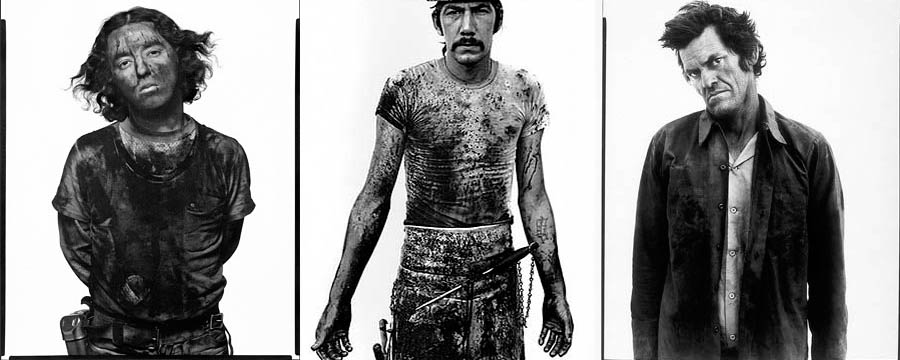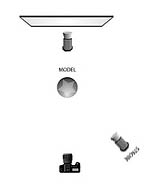In my eyes, Richard Avedon was a genius. A portrait photographer with a lust for life who could capture something unseen in a person, for someone who was supposedly in love with all things dramatic and energetic, Avedon was able to capture a calmness in his portraits, there is a candid quality to his photographs despite the obvious fact that they were setup.


His subjects posses an innocence, or is it complete trust? either way the character that he has drawn from relative strangers only adds to the mystery and firmly cements him as one of the greats.
It is my understanding that Avedon used daylight for these exposures and a combination of reflectors, flags and diffusers for this series as they were all shot on location.

Richard Avedon biography
Richard Avedon was an American photographer and artist born on May 15, 1923, in New York City. He is considered one of the greatest photographers of the 20th century and his work has had a profound influence on the world of fashion, art, and portraiture.
Avedon began his photography career at the age of 22 as an advertising photographer for a department store in New York City. He quickly made a name for himself with his innovative and striking images, which were marked by their minimalist style and clean lines. In 1946, he was hired as a staff photographer for Harper’s Bazaar, and it was there that he truly began to develop his signature style.
Throughout his career, Avedon was known for his striking black-and-white photographs, which were characterized by their stark contrast and minimalism. His portraits of celebrities and models were particularly renowned for their stark, minimalist style, which made his subjects appear almost sculptural. Avedon was also known for his work as a fashion photographer, and his images helped to define the look of American fashion during the 1950s and 1960s.
One of Avedon’s most famous works is his series of portraits of the American West, which he began in 1979. The project, which spanned over six years, involved traveling through the western United States and photographing people from all walks of life. The resulting images, which were published in a book called “In the American West,” are some of the most powerful and iconic photographs of the 20th century.
Avedon was also known for his work as a portrait photographer, and he photographed many of the most influential people of his time, including Andy Warhol, Marilyn Monroe, and the Beatles. His portraits were marked by their simplicity and their ability to capture the essence of his subjects. Avedon was known for his ability to put his subjects at ease and to capture their true character, even in the most formal of settings.
In addition to his photography, Avedon was also an accomplished artist and filmmaker. He created a number of short films, including “Funny Face,” which starred Audrey Hepburn and Fred Astaire. Avedon’s work as an artist often explored themes of mortality and the passing of time, and he was particularly interested in the ways in which images could be used to capture and preserve memories.
Throughout his career, Avedon won numerous awards and honors for his photography, including the National Medal of Arts, which he received in 1992. He continued to work until his death in 2004, and his legacy continues to influence photographers and artists to this day.
Avedon’s influence on the world of photography is difficult to overstate. His innovative approach to portraiture and fashion photography helped to transform the medium, and his work has inspired countless photographers and artists around the world. Avedon’s images are characterized by their simplicity, their striking contrast, and their ability to capture the essence of his subjects. His legacy continues to endure, and his work remains an essential part of the canon of modern photography.
Taking pictures in Avedon’s style
Where we are in the UK it isn’t quite as sunny so in our version a simple lighting setup of two Bowens 400rx flash heads were used, as well as a large white piece of paper and a 4×5 large format Horseman loaded with photo paper instead of 4×5 negatives. Both lights are set to full power, one is placed behind the model pointing toward the background and the other is placed to the right of the model.
 The light to the models right is elevated and angled down and across the face, this is commonly referred to as Rembrandt lighting or 45/45 lighting. Named after Rembrandt as it was typical of his portraits to be lit in this way and 45/45 because the light is at 45 degrees to the subject and angled down at 45 degrees. I recommend you use a lamp in a dark room and examine the light and how it falls across the face as you move it to see the effects. Rembrandt lighting is defined by the shadow in the shape of a triangle appearing underneath the subjects eye. The shadow of the nose completes the shadow, personal preference can dictate if the eye is illuminated or left in darkness.
The light to the models right is elevated and angled down and across the face, this is commonly referred to as Rembrandt lighting or 45/45 lighting. Named after Rembrandt as it was typical of his portraits to be lit in this way and 45/45 because the light is at 45 degrees to the subject and angled down at 45 degrees. I recommend you use a lamp in a dark room and examine the light and how it falls across the face as you move it to see the effects. Rembrandt lighting is defined by the shadow in the shape of a triangle appearing underneath the subjects eye. The shadow of the nose completes the shadow, personal preference can dictate if the eye is illuminated or left in darkness.

Mark Seliger and Nigel Parry are masters of simple lighting rigs and often employ the 45/45 technique, it’s a classic lighting method which every photographer should have in their arsenal.



The beauty of photography is that no matter what the scenario the shadows and highlights will give away how it was shot. If we examine this shot of Robin Williams we can see that based upon our knowledge of 45/45 lighting the brightest part of the image is the cheek on the right and the shadow is created by the nose, therefore we can assume that the light is on the right hand side of this image and angled slightly downward (left side if you’re the model).
Now the highlights in the eyes, otherwise referred to as catch-lights tell us exactly what lighting setup was used. The white lights in the eyes not only show us the direction of the light but also the type of light modifier used. A round white dot tells us that it’s either a standard reflector or a snoot, a white square box is a softbox, long thin line is going to be a strip light etc etc. In this case we can see that there are two rectangular shapes reflected in his eyes, these are two softboxes one at 45/45 above the subject as the key light or main light and the one below is the fill light which is used to soften the shadows and reduce contrast.
Back to our photo shoot
A simple two light setup, images exposed onto photo paper, developed, scanned and inverted.



